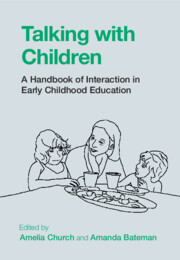Book contents
- Talking with Children
- Talking with Children
- Copyright page
- Dedication
- Contents
- Figures
- Tables
- Contributors
- Acknowledgements
- Notes on Transcription Conventions
- Introduction
- Part I Talk as Social Action
- Part II Pedagogy in Interaction
- Part III Interaction and Inclusion
- 15 Play
- 16 Mental Health and Wellbeing
- 17 Neurodiversity
- 18 Friendships
- 19 Conflict
- 20 Morality
- 21 Families
- Index
- References
16 - Mental Health and Wellbeing
from Part III - Interaction and Inclusion
Published online by Cambridge University Press: 16 June 2022
- Talking with Children
- Talking with Children
- Copyright page
- Dedication
- Contents
- Figures
- Tables
- Contributors
- Acknowledgements
- Notes on Transcription Conventions
- Introduction
- Part I Talk as Social Action
- Part II Pedagogy in Interaction
- Part III Interaction and Inclusion
- 15 Play
- 16 Mental Health and Wellbeing
- 17 Neurodiversity
- 18 Friendships
- 19 Conflict
- 20 Morality
- 21 Families
- Index
- References
Summary
Communicating effectively with children is fundamental to educational practice. As children spend a significant amount of time in education settings, there is increasing pressure on educators to promote positive mental health and wellbeing, participate in prevention of mental ill health, and work with children diagnosed with existing mental health conditions. However, communicating about mental health, wellbeing, and emotional regulation with children, and generally supporting those with need, can be a challenge. Educators need a communication toolkit to help them build their confidence and competencies in engaging in sensitive and critically important conversations. To develop this toolkit, we spotlight the communication practices used by mental health practitioners in clinical settings, translating key messages for educators. In this chapter we show how question design is instrumental for engagement, and detail ways to manage the complex endeavour of asking children about emotions, feelings, and wellbeing. The data illustrate some of the discursive techniques used by adults when communicating with children about mental health and wellbeing, illustrating examples of good practice for educators. To demonstrate this, we utilize excerpts of data from the assessments data and translate clinical practice into educational knowledge.
Keywords
- Type
- Chapter
- Information
- Talking with ChildrenA Handbook of Interaction in Early Childhood Education, pp. 331 - 351Publisher: Cambridge University PressPrint publication year: 2022



